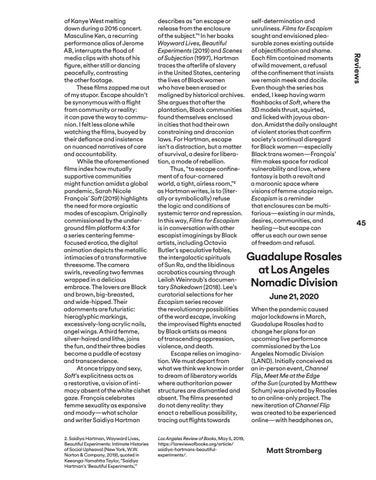describes as “an escape or release from the enclosure of the subject.”¹ In her books Wayward Lives, Beautiful Experiments (2019) and Scenes of Subjection (1997), Hartman traces the afterlife of slavery in the United States, centering the lives of Black women who have been erased or maligned by historical archives. She argues that after the plantation, Black communities found themselves enclosed in cities that had their own constraining and draconian laws. For Hartman, escape isn’t a distraction, but a matter of survival, a desire for liberation, a mode of rebellion. Thus, “to escape confinement of a four-cornered world, a tight, airless room,”² as Hartman writes, is to (literally or symbolically) refuse the logic and conditions of systemic terror and repression. In this way, Films for Escapism is in conversation with other escapist imaginings by Black artists, including Octavia Butler’s speculative fables, the intergalactic spirituals of Sun Ra, and the libidinous acrobatics coursing through Leilah Weinraub’s documentary Shakedown (2018). Lee’s curatorial selections for her Escapism series recover the revolutionary possibilities of the word escape, invoking the improvised flights enacted by Black artists as means of transcending oppression, violence, and death. Escape relies on imagination. We must depart from what we think we know in order to dream of liberatory worlds where authoritarian power structures are dismantled and absent. The films presented do not deny reality: they enact a rebellious possibility, tracing out flights towards
2. Saidiya Hartman, Wayward Lives, Beautiful Experiments: Intimate Histories of Social Upheaval (New York, W.W. Norton & Company, 2019), quoted in Keeanga-Yamahtta Taylor, “Saidiya Hartman’s ‘Beautiful Experiments,’”
Los Angeles Review of Books, May 5, 2019, https://lareviewofbooks.org/article/ saidiya-hartmans-beautifulexperiments/.
self-determination and unruliness. Films for Escapism sought and envisioned pleasurable zones existing outside of objectification and shame. Each film contained moments of wild movement, a refusal of the confinement that insists we remain meek and docile. Even though the series has ended, I keep having warm flashbacks of Soft, where the 3D models thrust, squirted, and licked with joyous abandon. Amidst the daily onslaught of violent stories that confirm society’s continual disregard for Black women—especially Black trans women—François’ film makes space for radical vulnerability and love, where fantasy is both a revolt and a maroonic space where visions of femme utopia reign. Escapism is a reminder that enclosures can be multifarious—existing in our minds, desires, communities, and healing—but escape can offer us each our own sense of freedom and refusal.
Guadalupe Rosales at Los Angeles Nomadic Division June 21, 2020 When the pandemic caused major lockdowns in March, Guadalupe Rosales had to change her plans for an upcoming live performance commissioned by the Los Angeles Nomadic Division (LAND). Initially conceived as an in-person event, Channel Flip, Meet Me at the Edge of the Sun (curated by Matthew Schum) was pivoted by Rosales to an online-only project. The new iteration of Channel Flip was created to be experienced online—with headphones on,
Matt Stromberg
Reviews
of Kanye West melting down during a 2016 concert. Masculine Ken, a recurring performance alias of Jerome AB, interrupts the flood of media clips with shots of his figure, either still or dancing peacefully, contrasting the other footage. These films zapped me out of my stupor. Escape shouldn’t be synonymous with a flight from community or reality: it can pave the way to communion. I felt less alone while watching the films, buoyed by their defiance and insistence on nuanced narratives of care and accountability. While the aforementioned films index how mutually supportive communities might function amidst a global pandemic, Sarah Nicole François’ Soft (2019) highlights the need for more orgiastic modes of escapism. Originally commissioned by the underground film platform 4:3 for a series centering femme- focused erotica, the digital animation depicts the metallic intimacies of a transformative threesome. The camera swirls, revealing two femmes wrapped in a delicious embrace. The lovers are Black and brown, big-breasted, and wide-hipped. Their adornments are futuristic: hieroglyphic markings, excessively-long acrylic nails, angel wings. A third femme, silver-haired and lithe, joins the fun, and their three bodies become a puddle of ecstasy and transcendence. At once trippy and sexy, Soft’s explicitness acts as a restorative, a vision of intimacy absent of the white cishet gaze. François celebrates femme sexuality as expansive and moody—what scholar and writer Saidiya Hartman
45
